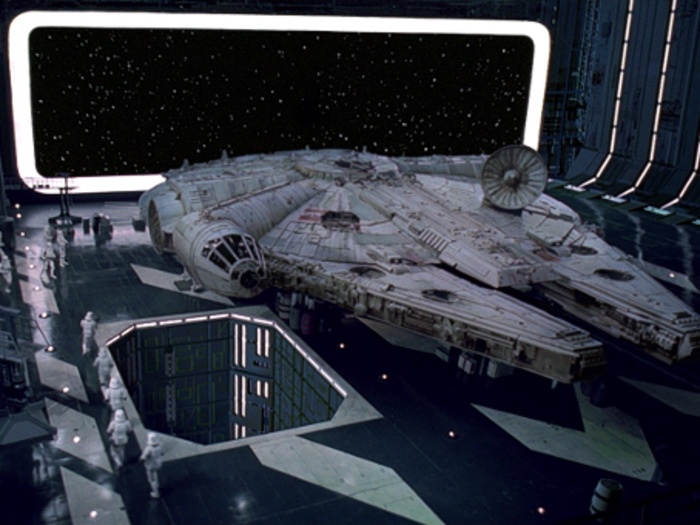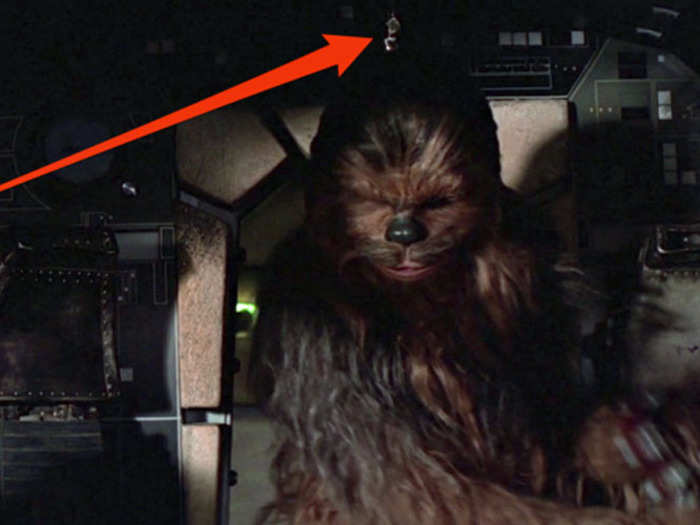- Home
- slideshows
- miscellaneous
- A creator of the original Millennium Falcon describes how the legendary 'Star Wars' ship was made with airplane scraps and lots of imagination
A creator of the original Millennium Falcon describes how the legendary 'Star Wars' ship was made with airplane scraps and lots of imagination
Creating references for a space western.

Building the Falcon out of junk.

By the end of 1976, “Star Wars” had found financing and the team moved to Elstree Studios in the UK to begin making the sets. Immediately they realized they didn’t have the space to build a full-scale set of the Millennium Falcon, so they built half of the exterior along with specific sections of the interior of the ship.
Christian’s idea of the Falcon having this look of, well, as Luke Skywalker famously said in the first movie, “a piece of junk,” led him to the junkyard.
“I had the idea that if I bought scrap junk airplanes I could break it down and build the sets,” Christian said. “That was key to making the Millennium Falcon.”
With an okay from Lucas, Christian set out to get the airplane scraps, which entailed him getting on a prop plane and flying to three different airfields that were basically airplane graveyards.
“I went in and found mountains of junk,” he said. “I could buy it for nothing. I bought 20 jet engines, a ton of cockpit gear, containers that they used to heat up food, anything I could get my hands on."
It was all sold by weight so most if was very cheap to purchase because it was light metal for airplanes.
“It would be 50 pounds for a whole load,” Christian said.
Back at Elstree, the prop room was completely cleared out and a giant 18-wheeler pulled right up and all the airplane scraps Christian bought were unloaded into the room. The prop department was then instructed to break it all down, as Christian would then use certain pieces for the interior Falcon sets.
“I had no clue if any of this would work,” Christian said. “But George loved it.”
Matching the work done in America — sometimes to a fault.

The team at Elstree weren’t the only ones working on making the Falcon. Back in the US, visual effects artist Joe Johnston (he would go on to direct “The Rocketeer,” “Jumanji,” and “Captain America: The First Avenger”) and his team were building a model of the ship, which would be be used for the exterior shots as well as a guide for the art team in the UK.
But this was the 1970s, and the process to see each team’s work took days and led to miscommunication at times.
“There weren’t any fax machines back then, we had a pouch that would be mailed every Tuesday to America and Thursday it would come back,” Christian said. “We were sent pictures of the model and John Barry and the draftsman had to match that. They would build it full scale and I would find scrap that I could match and stick to the sides. It was a brand new process. No one had done this before.”
When they were done with a section in the UK, they would then take pictures of the Falcon set and send them back in the pouch to the US so Johnston and his team made sure the model matched.
However, Christian pointed out that their pouch system wasn’t mistake free. There is one error to this day that’s on the Millennium Falcon, though it’s impossible to find.
Christian said one Thursday the pouch came back and Johnston wrote a note to the team, “You built in my mistake.”
Turns out the previous round of photos of the model sent to the UK were taken when Johnston was still working on it.
“Just before they photographed it, Joe didn’t like one piece and pulled it off, expecting to replace it,” Christian said. “They photographed it before he did that. The photo came back in the pouch and we built it. So somewhere on the Millennium Falcon there’s glue marks where a piece is missing that we built full-scale. Neither Joe or I can remember where it is exactly. It’s on there somewhere.”
Creating the ship’s iconic interior sets.
Christian said the first interior set they built was the cockpit in the Millennium Falcon. And what stands out to him to this day is working with Harry Lange, the production designer on Stanley Kubrick’s “2001: A Space Odyssey.”
Christian walked into the cockpit ready to dress it when Lange and his team were through, and he entered a set that was pristine and neat.
“I said, ‘Harry, I’m going to come in and completely mess it up,’” Christian said. “This is Han Solo’s ship, it’s old and beaten up and gambled for. So I bought some old fighter pilot seats. I got bits of old aircraft controls for the dashboard. And then I made it look all worn. I took George to see it and he loved it.”
But Christian said building the ship’s main hull — where Chewbacca plays chess — drove him nuts.
“I kept buying more and more scrap for it,” he said. “The whole thing was encrusted like a submarine and it looked terrible. But it’s one of those things where it doesn’t look right until you’re almost done and then it came to life. I put oil and grease on everything to grunge it up.”
By the time Christian was done with that set, Lucas loved it so much it became the spot that he showed all his director friends and studio executives when they would visit the production, according to Christian.
How the dice were born.

Though the dice hanging in the cockpit of the Millennium Falcon have become widely known thanks to the use of them in “Star Wars: The Last Jedi,” when “A New Hope” opened in 1977, audiences had to have a sharp eye to catch them.
Their major moment is when Chewbacca’s head knocks into them when going into the cockpit of the Falcon (Christian said you don’t see them the rest of the movie because someone took them down between shooting scenes, and they where never put back on).
A big reason the dice were even there in the first place was because Christian wanted “Star Wars” to have as good of luck as Lucas’ biggest hit at that point of his career, 1973’s “American Graffiti.”
“Ron Howard’s car in 'American Graffiti' had dice hanging from it, and that made more money than any independent film at the time,” Christian said. “And I felt it would suit the Han Solo character. So I suggested to George I make dice.”
Lucas was game and days later Christian presented Lucas with six pairs — including big woolly ones, plastic ones, and chrome. Lucas picked the chrome ones.
The dice were thought to be lost forever as they never appeared again after “A New Hope.” But when the franchise was resurrected by J.J. Abrams with “The Force Awakens,” it was brought to Christian’s attention that the dice appeared in a photo of the Falcon cockpit in a spread in Vanity Fair.
“J.J. got an assistant to go search for the dice I made, it took them months, apparently,” Christian said. “But then he cut it out of the movie.”
“The Last Jedi” is the triumphant return of the dice (a gold color this time instead of the original chrome). And Christian can’t wait to see how they are used in “Solo.”
“The irony is Ron Howard directed ‘Solo’ and the dice is inspired by his car in ‘American Graffiti,’” he said.
Why the Millennium Falcon is still one of the most memorable ships in the galaxy.

It’s been 43 years since Christian and others on “A New Hope” brought the Millennium Falcon to life and it’s still one of the most beloved aspects of the franchise. Its unique look and heroics in the movies are partly responsible for the obsession fans have for all things “Star Wars.” One man in Nashville loves the ship so much he’s spent years trying to make a full-scale model of it.
Christian believes the love for the ship to this day is because of its personality and the person piloting it.
“I think it has to do with Han Solo,” Christian said. “Everyone loves the lovable rogue and the personality Harrison Ford gave the character personified that. He's kind of an underdog and he's always in trouble and his ship always gets him through somehow — that made the ship become a character of its own.”
“I got a model of it in my office here and I'm looking at it right now and there's something about it — the shape, it shouldn't work, it doesn't have wings, but it does,” Christian continued. “That's why it has an indelible impression on everybody. It's not this flashy thing that can do anything. In a way it's a mystery but it's a mystery you can believe in.”
Popular Right Now
Popular Keywords
Advertisement